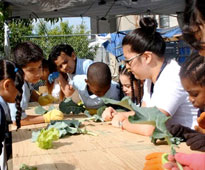With the emergence of the Next Generation Science Standards, and Congress considering whether to include experiential environment-based outdoor learning in the Elementary and Secondary Education Act, we thought this might be a good time to sum up what the research literature says about gardens as a learning asset for schools.
We are fortunate that a quite helpful literature survey was published just
two years ago.(Williams and Dixon 2013). It is a summative assessment of 48 studies (between 1990 and 2010) of the various effects of school gardens on learning and other outcomes. It found:
 *“The results of the studies show overwhelmingly that garden-based learning
*“The results of the studies show overwhelmingly that garden-based learning
had a positive impact on students’ grades, knowledge, attitudes, and
behavior. These positive impacts prevailed for nearly every outcome group,
including the elementary, middle, and high school levels, with positive
impacts of 85%, 83%, and 91%, respectively, although the number of studies
at the high school level was the lowest. The preponderance of overall
positive findings is important since research methodologies of the 48
studies were found to be highly eclectic. These findings speak to the
potential of garden programs in benefiting academic and academic-related
outcomes.*
*However, these results also indicate that garden instructional activities
may need more curricular development and integration with particular
subject areas if they are intended to improve academic performance. Perhaps
garden-based learning could serve as one venue to advance the recent
interest in education reform promoting Science, Technology, Engineering,
and Mathematics (STEM) initiatives (National Science Foundation, 2010) and
for career prospects in horticulture, landscape design, and architecture,
as well as food, nutrition, and health.” *
While it found many weaknesses in methodology among the various studies,
taken as a whole, the advantages were overwhelmingly positive because
school gardens support constructivist learning. The studies show particular
support for science and STEM learning. The finding of the need for more curricular development seems highly relevant to NGSS implementation. The AFWA *North American Conservation Education Strategy*, as an example, has a
useful *schoolyard biodiversity field investigation guide that addresses this need as does the Eco Schools USA *biodiversity pathway”
A look at more recent studies provides additional information on the learning attitudes and confidence levels of the children.
(Radcliffe et al. 2011) , (Block et al. 2012) And, includes the PNAS article on improved cognitive development and green
outdoor spaces (Dadvand et. al. 2015)
Kevin J. Coyle, JD.
Vice President, Education and Training
National Wildlife Federation www.nwf.org
